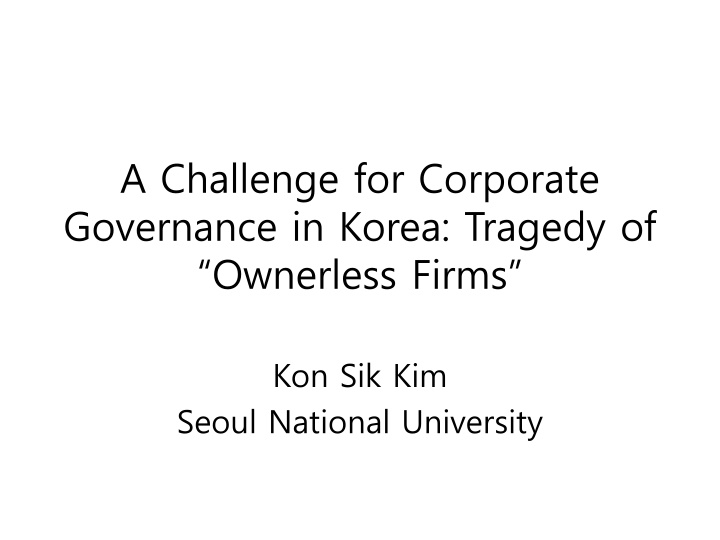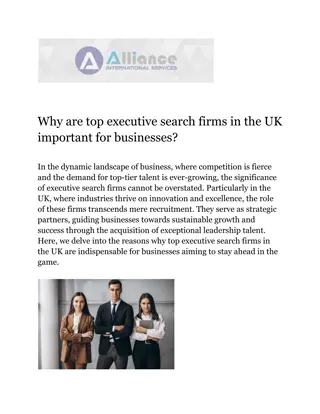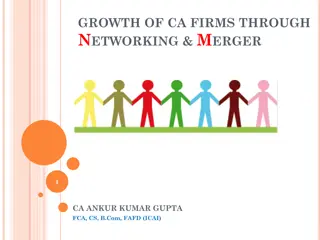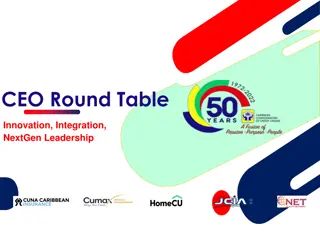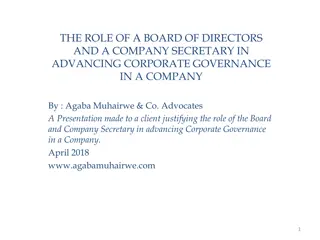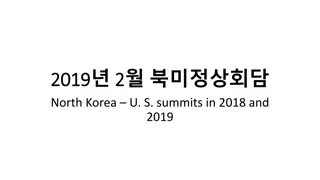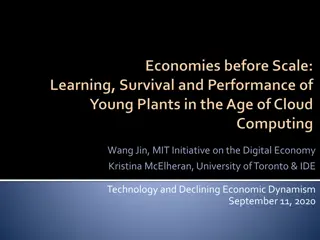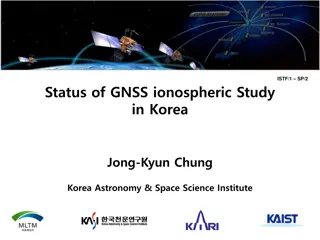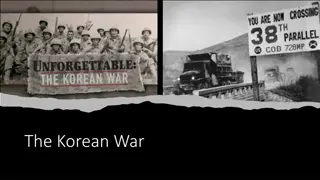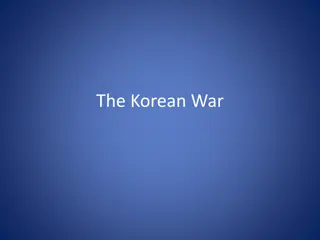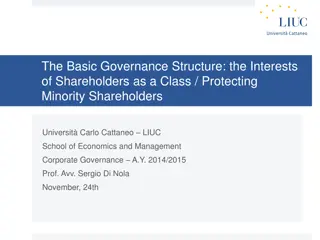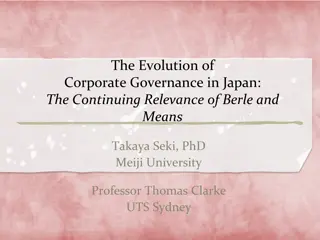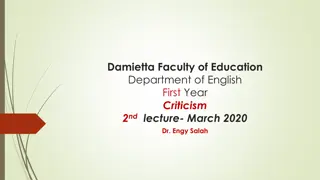Challenges of Corporate Governance in Korea: The Tragedy of Ownerless Firms
Exploring the complexities of corporate governance change in Korea, focusing on the structure involving controlling minority shareholders (CMS). The interplay of ownership structure, firm behavior, political environment, and the stability of CMS pose significant challenges, impacting long-term growth and performance.
Download Presentation

Please find below an Image/Link to download the presentation.
The content on the website is provided AS IS for your information and personal use only. It may not be sold, licensed, or shared on other websites without obtaining consent from the author.If you encounter any issues during the download, it is possible that the publisher has removed the file from their server.
You are allowed to download the files provided on this website for personal or commercial use, subject to the condition that they are used lawfully. All files are the property of their respective owners.
The content on the website is provided AS IS for your information and personal use only. It may not be sold, licensed, or shared on other websites without obtaining consent from the author.
E N D
Presentation Transcript
A Challenge for Corporate Governance in Korea: Tragedy of Ownerless Firms Kon Sik Kim Seoul National University
Introduction What is Corporate Governance Change? Controlling Minority S/H(CMS) Structure Corporate Governance and Political Environment A Problem of Corporate Governance Change? Tragedy of Ownerless Firms Conclusion 2
Corporate Governance Change Debate as to convergence vs. path dependence in corporate governance Q: How do you measure the change in corporate governance? A: The most fundamental criterion seems to be the purpose for which firms are actually managed. It is difficult to grasp from outside such purposes of firms. 3
Corporate Governance Change Instead, it is easier to identify those who control a firm. Depending on who controls a firm, the firm s behavior may differ. In identifying a controller, the share ownership structure is crucial. Ownership structure -> controller -> firm s behavior 4
CMS Structure The ownership structure of large Korean firms is often characterized as controlling minority shareholder (CMS) structure. A controlling minority shareholder effectively controls the whole group of firms with the help of inter-company shareholdings. 5
CMS Structure CMS 51% 5% A minority S/H 20% 55% 51% 51% D C B 20% 6
Stability of CMS Structure internal ownership CMS member firms
Problems of CMS Structure With no plan to sell his shares, CMS is interested not in share price, but in the long-term growth. Entrenchment effect long-term perspective vs. tunneling It is difficult to determine the effect of the CMS structure on performance. 8
Corporate Governance & Political Environment Corporate governance change, especially a change affecting the ownership structure, may take place only when the political environment supports it. Given the predominance of chaebol in most fields of society, a fundamental change in ownership structure is difficult, if not impossible, to achieve. 9
Political Environment Allies Managers and employees Suppliers and distributers Government Media Politicians Academia etc. Enemies - NGOs - Liberal intellectuals and politicians - General investors, including foreign investors 10
Changes in Political Environment Growing general antipathy toward chaebol owners Causes: - unfair business practices related to dynasty-like succession - growing gap between the rich and the poor (chaebol firms and small and medium size firms - Negative happenings 11
Unfair business practice - old Issuance of equity securities to heirs of CMS at unfair prices Samsung Group Some of those involved in this kind of scheme got convicted. Chairman Lee of Samsung Group narrowly avoided conviction by the 6-5 decision at the Supreme Court. 12
Unfair business practice recent Corporate opportunity + self dealing 1. X, a son of CMS, sets up a new firm Y 2. all the member firms exclusively deal with Y at unfair(or apparently fair) prices 3. Y goes public 4. X secures the control block in the parent company with the funds from the IPO Ex. Hyundai Motor Co. Group (An investment of $3 million has grown to about $2 billion in 11 years.) 13
Controversial business practices It is a wide-spread practice for heirs of CMS to engage in business activities with the expectation of the group support. Some daughters of chaebol had to move out of the bakery business due to the public criticism that they drive independent bakery shops out of business. 14
Political Environment election 2012 is the year of the election: general election in April and the presidential election in December Politicians turn to this issue to seek votes - regulating inter-company shareholding - encouraging the National Pension Fund to play a more active role in corporate governance 15
Tragedy of Ownerless Firms Even among large listed firms, only a handful of them have no individual controlling shareholder. These firms are often called ownerless firms Most of ownerless firms are former government-owned firms which have gone public as a way of privatization. Most financial holding companies with bank subsidiaries have no controlling shareholders. 16
Tragedy of Ownerless Firms POSCO: steel manufacturer KT: telecom firm KT&G: tobacco and ginseng firm KB Financial Holdings Shinhan Financial Holdings Hana Financial Holdings 17
Tragedy of Ownerless Firms Ownerless firms are supposed to be run by professional managers elected by the board. The board of directors is in turn composed primarily of outsiders. Most of them have been enjoying an excellent reputation in terms of corporate governance. 18
Tragedy of Ownerless Firms CEO changes in all these firms after the change of government in 2008 Most of the changes occurred in awkward situations. CEO of KT resigned as he was indicted for taking bribes from the CEO of its subsidiary. CEO of POSCO stepped down in the middle of his term, and a close aide to President Lee is reported to have influenced the succession process. 19
Tragedy of Ownerless Firms Growing concern that these ownerless firms turn into spoils of the power elites. Ownerless firms may provide job opportunities and business opportunities. CEO change may occur whenever there is a change in political leadership. 20
Tragedy of Ownerless Firms If such phenomenon continues, the ownerless firms will likely stagnate due to the so-called tragedy of commons . As long as the tragedy of ownerless firms is not reined in, it may not be wise to turn chaebol firms into ownerless firms. 21
Conclusion The tragedy of ownerless firms is a part of a bigger problem of ownerless institutions in Korea. Ownerless institutions rarely succeed in Korea. An owner often exists even in non- profit institutions, such as churches, universities and hospitals. While people are critical of chaebol owners, they generally believe that an ownerless institution will rarely succeed. 22
Conclusion It is difficult to change the existing CMS structure into a widely dispersed ownership structure. It seems even more difficult for ownerless firms to compete adequately with chaebol firms. A challenge for Korea is how to secure an environment that enables an ownerless firm to operate efficiently without falling prey to the power elites. 23
Conclusion Emergence of successful ownerless firms (and institutions) may be regarded as evidence that Korea has actually joined the ranks of advanced countries. 24
